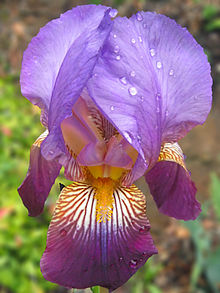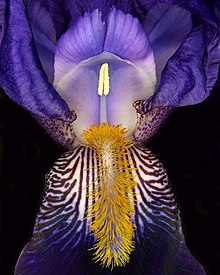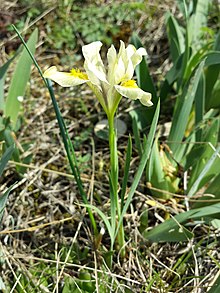| Iris subg. Iris | |
|---|---|

| |
| Purple bearded iris | |
| Scientific classification | |
| Kingdom: | Plantae |
| Clade: | Tracheophytes |
| Clade: | Angiosperms |
| Clade: | Monocots |
| Order: | Asparagales |
| Family: | Iridaceae |
| Subfamily: | Iridoideae |
| Tribe: | Irideae |
| Genus: | Iris |
| Subgenus: | Iris subg. Iris B.Mathew |
Subgenus Iris is one subgenus of Iris.
Iris as a plant was originally named by Carl Linnaeus in his book Systema Naturae (in 1735), with a great number of species being added into the genus. Including new ones that were found after the book's publication. The division of irises into various subgroups, has taken various forms over the years. By the 19th century botanists had created new genera such as Evansia, Hermodactylus, Moraea, Oncocyclus, and Xiphion. Opinion was often divided whether to split the genus into several parts or lump them back into Iris. From J. G. Baker, who separated some such as Moraea and Xiphion from Iris in his book 'Handbook of the Irideae' (published in London) in 1892. Then William R. Dykes, who clarified the situation by a compromise in his monograph The Genus Iris (by Cambridge University Press, 1913; later reprinted in 1974 by Dover). He was the first to term the subgroup as Iris sect. Iris. G. Rodionenko [ru]'s 1961 reclassification in The Genus Iris (written in Russian, Moscow, 1961) was more comprehensive in that he split the genus into five genera: Iris (which included all rhizomatous irises). A taxonomic revision by Brian Mathew in 1981 (The iris, New York: Universe Books), recognized six subgenera: Nepalensis Dykes, Xiphium (Miller) Spach, Scorpiris Spach, Hermodactyloides Spach, Iris L. and Limniris Tausch. Recently, DNA analysis has been used to determine groupings.
The Iris subgenus has been divided into six sections; bearded irises (or pogon irises), Psammiris, Oncocyclus, Regelia, Hexapogon and Pseudoregelia. Sections Oncocyclus and Regelia are also called aril irises.
Section bearded irises (or pogon irises)

This is the largest section of the subgenus, the true bearded irises. Most irises come from Southern or eastern Europe. 'Pogon' refers to the Greek word for beard. It has several species of iris including;
- Iris adriatica Trinajstic ex Mitic
- Iris albertii
- Iris albicans—white flag Iris, white cemetery iris.
- Iris alexeenkoi Grossh.
- Iris aphylla L.—stool iris, table iris, leafless iris.
- Iris attica (Boiss. & Heldr.) Hayek
- Iris benacensis A.Kern. ex Stapf
- Iris bicapitata Colas.
- Iris croatica—Perunika; endemic to Croatia.
- Iris cypriana Foster & Baker—endemic to Cyprus.
- Iris flavescens Delile—lemon-yellow iris
- Iris florentina L.—syn: Iris germanica nothovar. florentina (L.) Dykes
- Iris furcata Bieb.—forked iris.
- Iris × germanica L.—German iris (includes I. × barbata).
- Iris glaucescens Bunge
- Iris griffithii Baker
- Iris hellenica Mermygkas
- Iris illyrica (often included in I. pallida)—endemic to Balkan Peninsula.
- Iris imbricata Lindl.
- Iris junonia Schott ex Kotschy
- Iris kashmiriana Baker
- Iris lutescens Lam. (including I. italica)
- Iris marsica I.Ricci & Colas.
- Iris mesopotamica—Mesopotamian iris
- Iris orjenii—Orjen iris
- Iris pallida—sweet iris, Dalmatian iris
- Iris pallida subsp. cengialti – Iris cengialti
- Iris perrieri Simonet ex P.Fourn.
- Iris pseudopumila Tineo
- Iris pumila L.
- Iris purpureobractea B.Mathew & T.Baytop
- Iris relicta Colas.
- Iris reichenbachii Heuff.—Reichenbach's iris
- Iris revoluta Colas.
- Iris sambucina L.
- Iris scariosa Willd. ex Link
- Iris schachtii Markgr.
- Iris suaveolens Boiss. & Reut. (including I. iliensis)
- Iris subbiflora Brot.
- Iris taochia Woronow ex Grossh.
- Iris timofejewii Woronow
- Iris variegata L.—Hungarian iris

It also includes thousands of ornamental plant cultivars, which have been divided into various height categories.
- MDB – Miniature dwarf bearded
- SDB – Standard dwarf bearded
- IB – Intermediate bearded
- BB – Border bearded
- MTB – Miniature tall bearded
- TB – Tall bearded
Psammiris
This section of irises was first described by Spach. Most of the Irises come from Russia and Northwest China. Mostly rhizomatous, and flowering in late spring. 'Psammiris' is derived from the Greek word psammos for sand.

It includes;
- Iris arenaria Waldst. and Kit.
- Iris bloudowii Bunge.
- Iris curvifolia Zhao
- Iris humilis Georgi
- Iris kamelinii Alexeeva
- Iris mandshurica Maxim.
- Iris potaninii Maxim.
- Iris vorobievii N.S.Pavlova
Oncocyclus

Oncocyclus irises are rhizomatous perennials. They also generally need rich soils that drain easy and are in full sun. Most also prefer a dry period after flowering. The Oncocyclus irises are mostly from Turkey, Caucasus and Iran. The plants usually have only one flower, which is veined or spotted. Some of these species have been bred with bearded irises to create unique colours and markings. Oncocyclus is a Greek word, with onco meaning mass, or bulk, and cyclus meaning circle. In 1846, the term 'Oncocyclus' was first used by C.H. Siemssen as the Genus Oncocyclus in 1846 in Botanische Zeitung. Baker then re-classified it to a subgenus in 1877, than Dykes lowered it to a section in 1914, where it currently remains.
- Iris acutiloba C.A.Mey. (including I. ewbankiana )
- Iris acutiloba subsp. lineolata (Trautvetter) Mathew and Wendlobo
- Iris acutiloba subsp. longitepala Mathew & Zarrei
- Iris antilibanotica Dinsmore
- Iris assadiana Chaudhary, Kirkw. & C.Weymolauth
- Iris auranitica Dinsmore
- Iris atrofusca Bak.
- Iris atropurpurea Bak.
- Iris barnumiae Bak. & Fost.
- Iris barnumiae subsp. demawendica (Bornm.) B.Mathew & Wendelbo
- Iris basaltica Dinsmore
- Iris bismarckiana Reg. – Nazareth iris
- Iris bostrensis Mouterde
- Iris camillae Grossh.
- Iris cedreti Dinsm. ex Chaudhary
- Iris damascena Mouterde
- Iris gatesii Foster
- Iris grossheimii Woronow ex Grossh.
- Iris haynei Baker – Gilboa iris
- Iris heylandiana Boiss. & Reut.
- Iris hermona Dinsmore – Hermon iris
- Iris iberica Hoffm.
- Iris iberica subsp. elegantissima (Sosn.) Fed. & Takht.
- Iris iberica subsp. lycotis (Woronow) Takht.
- Iris kirkwoodi (including I. calcarea)
- Iris lortetii Barbey ex Boiss.
- Iris mariae Barbey.
- Iris meda Stapf
- Iris nigricans Dinsm.
- Iris paradoxa Steven
- Iris petrana Dinsm.
- Iris sari Schott ex Bak.
- Iris susiana L. – mourning iris
- Iris westii Dinsm.
- Iris yebrudii Dinsm. ex Chaud.
Regelia

Mostly from the mountainous regions of Iran, Afghanistan and the Altai Mountains. Most irises have a stem that has 2 flowers. It was named in 1904 by Robert Lynch in his book The Book of The Iris after Dr Regel.
- Iris afghanica Wend
- Iris darwasica Regel
- Iris heweri Grey-Wilson & B. Mathew
- Iris hoogiana Dykes
- Iris korolkowii Regel
- Iris kuschkensis Grey-Wilson & B. Mathew
- Iris lineata Foster ex Regel
- Iris stolonifera Maxim.
Hybrids of Regelia irises and Oncocyclus irises are known as Regelicyclous.
Hexapogon
Mostly from the desert area of Central Asia, Iran and Afghanistan. Most irises have beards on the falls and standards. Etymologically, hexa refers to the number 6 and pogon refers to the Greek word for beard.
- Iris falcifolia Bunge
- Iris longiscapa Ledeb.
Pseudoregelia
Mostly from the mountainous regions of Eastern Asia. Most irises have flowers that have blotches or colour spots on.
- Iris cuniculiformis Noltie & K.Y.Guan
- Iris dolichosiphon Noltie
- Iris goniocarpa Bak.
- Iris hookeriana Fost.
- Iris ivanovae Doronkin
- Iris kemaonensis Wall.
- Iris leptophylla Lingelsheim
- Iris narcissiflora Diels.
- Iris psammocola Y.T.Zhao
- Iris sikkimensis Dykes
- Iris tigridia Bunge ex Ledeb.
References
- "The Genus Iris". mathcs.clarku.edu. Retrieved 29 July 2021.
- ^ Stebbings, Geoff (1997). The Gardener's Guide to Growing Irises. Newton Abbot: David and Charles. p. 18. ISBN 0-7153-0539-5.
- Samad, Nour Abdel; Dagher-Kharrat, Magda Bou; Hidalgo, Oriane; El Zein, Rana; Douaihy, Bouchra; Siljak-Yakovlev, Sonja (15 August 2016). "Unlocking the Karyological and Cytogenetic Diversity of Iris from Lebanon: Oncocyclus Section Shows a Distinctive Profile and Relative Stasis during Its Continental Radiation". PLOS ONE. 11 (8): e0160816. Bibcode:2016PLoSO..1160816A. doi:10.1371/journal.pone.0160816. PMC 4985135.
- ^ Stearn, William (1972). A Gardenerer's Dictionary of Plant Names. London: Cassell. p. 211. ISBN 0-304-93721-5.
- Morris, Jim (2011). "Bearded Iris Classifications". www.irises.org (American Iris Society). Retrieved 24 July 2014.
- British Iris Society A Guide to Species Irises: Their Identification and Cultivation, p. 60, at Google Books
- Christopher Brickell RHS Encyclopedia of Plants and Flowers , p. 521, at Google Books
- "Aril Irises". pacificbulbsociety.org. Retrieved 1 March 2016.
- Saad, Layla; Khuri, Sawsan (4 August 2003). "Hanging in There by a Fall – The Oncocyclus Irises of Lebanon" (PDF). orbi.ulg.ac.be. Retrieved 23 July 2014.
- Pries, Bob (11 June 2014). "Section Oncocyclus". wiki.irises.org. Retrieved 2 March 2015.
- Cassidy, G.E.; Linnegar, S. (1987). Growing Irises (Revised ed.). Bromley: Christopher Helm. pp. 144–145. ISBN 0-88192-089-4.
- The book of the iris, by R. Irwin Lynch. www.biodiversitylibrary.org. p. 116. Retrieved 24 July 2014.
- Christopher Brickell RHS Encyclopedia of Plants and Flowers, p. 610, at Google Books
| Iris | |
|---|---|
| List of Iris species | |
| Iris subgenera | |
| Common names |
|
| Breeding and research | |
| Products | |
| Gardens and festivals | |
| Organizations | |
| Iris in art and culture | |
| Iris subg. Iris | |
|---|---|
| Section Iris |
|
| Section Oncocyclus | |
| Section Hexapogon | |
| Section Psammiris | |
| Section Pseudoregelia | |
| Section Regelia | |
| Taxon identifiers | |
|---|---|
| Iris subg. Iris |
|